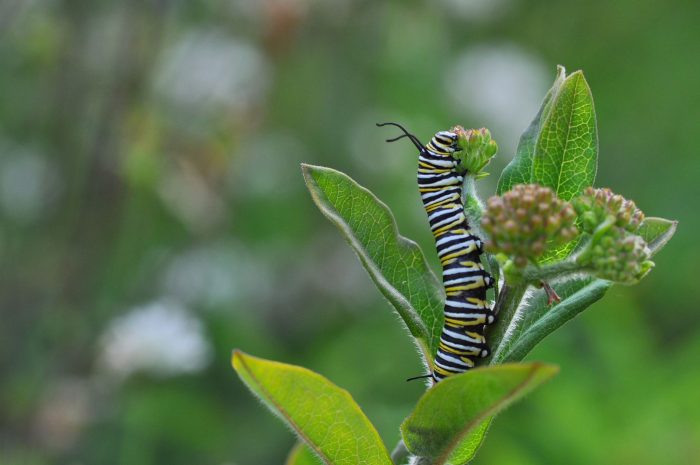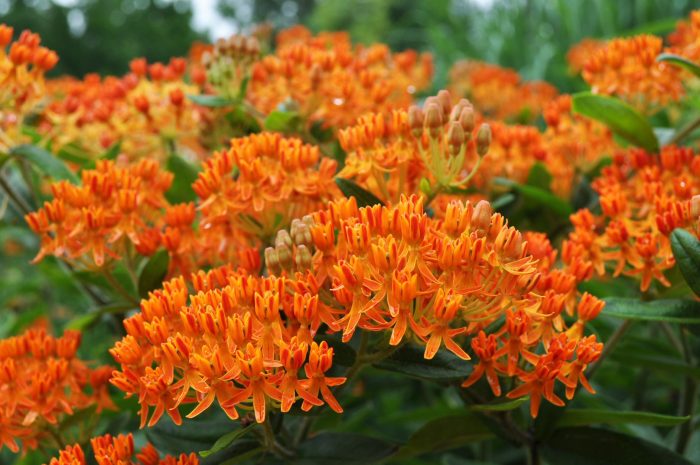A Carolina biologist explains the insect’s decline, and a horticulturalist recommends planting milkweed to benefit butterflies — and our ecosystem.

Many admire migratory monarch butterflies for their beauty and their annual journey across the Americas, but the beloved orange-winged creatures have recently found themselves on the Red List of Threatened Species, curated by the International Union for Conservation of Nature.
This latest Red List update “highlights the fragility of nature’s wonders,” said Bruno Oberle, director general of the IUCN, in a July 21 statement.
The monarch native population shrank between 22% and 72% over the past decade, according to the IUCN.
Allen Hurlbert, professor in the College of Arts and Sciences’ biology department, researches the impact of climate change on biodiversity and the geographic patterns of birds and insects, including butterflies like the monarch. He started Caterpillars Count!, a citizen science project that measures the seasonal variation of arthropods like caterpillars on trees and shrub foliage. At more than 150 sites across North America, anyone interested can conduct branch surveys, collect data and submit their findings.
Hurlbert said monarchs differ from most butterflies due to their migratory nature.
Monarch butterflies found in North America fall into two populations — eastern and western.
Populations found to the east of the Rocky Mountains undergo a multigenerational migration from Mexico to as far north as Canada and back again over the course of the year.
A smaller monarch population lives west of the Rockies throughout the Northwest and Southwest and only migrates as far as Southern California during winter.
Eastern monarchs heading to Mexico pass through the North Carolina mountains during their fall journey south.
Hurlbert attributes the monarch’s decline to several factors.
Habitat loss
Deforestation can impact the monarch population.
“They’re really susceptible to habitat loss in these very special areas where monarchs just literally drape the trees by the thousands and thousands, or even millions in some cases,” said Hurlbert.
Hurlbert said the butterflies are also vulnerable because their caterpillars and larvae are specialists, meaning they can only feed and grow on milkweed plants, while many other butterflies are generalists and feed on different types of leaves.

Historically, milkweed was found on the edges of agricultural fields or on roadsides, but that is changing.
“With the advent of genetically modified crops, farmers can broadly apply herbicide to kill all the weeds, knowing their crop is resistant, so there’s a lot less milkweed in those agricultural lands than there used to be,” said Hurlbert.
Weather events and climate change
Hurlbert said small, localized and short-duration weather events, like an intense storm or an ill-timed cold front or heat wave, could potentially take out a large percentage of the monarch population if it happened where many butterflies were gathered.
Throughout history, there have always been heat waves, cold fronts and storms, but increased frequency of these weather events can contribute to species decline and is directly tied to climate change.
“Climate change is shifting the timing and availability of conditions under which monarchs thrive,” said Hurlbert. “Also, it may be upsetting the seasonal timing or the synchrony between monarchs and the plants that they use.”
Hurlbert noted milkweed as an example, saying if the timing of plant growth shifts and monarchs arrive at a place where milkweed hasn’t popped up yet, they will be unable to lay their eggs.
How can we help?
Hurlbert said the unfortunate news of the monarch’s new endangered status isn’t surprising, but a widely admired species being threatened may propel people into action.
“The silver lining is the attention being drawn to these declines. The monarch butterfly is certainly not the only species that’s been undergoing large-scale declines over the last several decades. But it’s a very iconic one,” he said. “It raises eyebrows; it raises people’s concern level. Ideally, it brings attention to this broader problem of ecosystem health and species declines in general.”
Members of the public can aid the monarch population by growing milkweed, avoiding the use of pesticides and participating in community caterpillar monitoring and reporting.
Planting milkweed
The North Carolina Botanical Garden manages several natural areas in and out of Chapel Hill, some with naturally occurring populations of milkweed, said Daniel Stern, director of horticulture at the North Carolina Botanical Garden.
Milkweed leaves are critical to the monarch caterpillar’s exclusive diet, Stern said. And once flowered, the plant supports a wide variety of pollinators.
“People planting more milkweed is going to support more insect life, which then supports all order of animal life above that.”
Stern said the most common types of milkweed in the area are:
- Butterfly milkweed (Asclepias tuberosa) — orange or yellow low-growing herbaceous perennial that tolerates dry, sandy soils.
- Swamp milkweed (Asclepias incarnata) — taller, narrower plant with pink or light purple flowers that tolerates moist sites and heavy soils.
- Common milkweed (Asclepias syriaca) — great host plant, can be aggressive in small garden spaces but a great for a natural meadow or open area.

Stern said he’d recommend planting in the fall because it’s easier for plants to become established rather than the spring when it heats up quickly.
If you’re looking to plant from the seed, Stern said to sow them in a plastic pot, water gently and allow to drain for at least 12 hours. Next, place the pot in a sealed plastic bag and store in the refrigerator for six to eight weeks. After taking them out of the fridge, remove the plastic bag and place them in a warm, bright spot protected from digging animals and direct rain. After germination, separate the seedlings into individual pots and let them grow for the remainder of the season before transplanting to the garden.

Another option would be to buy whole plants and put those in the ground before and during early fall.
On Sept. 24, two days after the season’s official start, the Botanical Garden will host its annual Fall Plant Sale. Native wildflower seeds, shrubs, trees, vines and ferns will be available for purchase, along with milkweed, one of the most popular offerings.
“It’s one of the things that we sell out of most quickly,” said Stern.

Growing milkweed in your yard, taking hikes to check leaves for caterpillars and using the monarch’s example to raise awareness of species declines are all ways you can contribute to “the great power of citizen science,” Hurlbert said. Thousands of people across the continent have the potential to gather more information than any one scientist could on their own.
By Emily Padula, The Well
